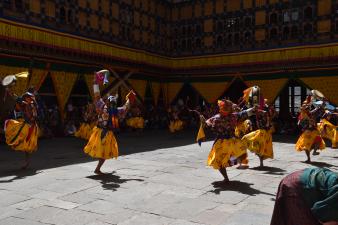 Drametse Ngacham: The Masked Drum Dance of Drametse
Drametse Ngacham: The Masked Drum Dance of Drametse
The Masked Dance of the Drametse community is a sacred dance performed during the Drametse festival in honor of Guru Padmasambhava, a Buddhist master. The dance performance also commemorates the founder of the Tegchok Namdroel Ogyen Choeling Monastery, Ani Choeten Zangmo; and venerable Khedurp Kuenga Gyeltshen (1505-/) who introduced the Masked Dance. These two are the eldest daughter and the fourth son respectively of the great treasure revealer, Terton Pema Lingpa (1450-1521). According to oral accounts, Drametse Ngacham was introduced in 1518, just three years before the death of Pema Lingpa. The name of the mask dance is derived from the Drametse village community, which falls within the Drametse gewog village block of Mongar Dzongkhag district in the eastern part of Bhutan. The term Ngacham refers to the dance implements held by performers, a hand-held circular flat drum and mallet. Tegchok Namdroel Ogyen Choeling Monastery was established in 1530. The three-day Drametse Tshechu festival takes place twice a year, organized by the monastery administration. The dancers include monks from the monastery as well as laymen. The origin of the mask dance, its characteristic choreography, masks, and costumes are specified in detail in the Kabum, Collected Works, of Pema Lingpa. Pema Lingpa have seven siblings and Sangdag is one of his sons who fathered Tenzin Chogyal and gave birth to Ani (Nun) Choeten Zangmo. Therefore, Ani Choeten Zangmo is the great grand daughter of Pema Lingpa. Though Ani Choeten Zangmo has no intention to indulge in the leading a family, she was forced to marry Yeshey Gyalpo, son of Sumthrang Choeje Sherab Drakpa. Driven by her destiny, she became renunciate and later established her permanent seat at Drametse where she recognized a place of peace and tranquility, Dra-me “No Obstructions” to her meditational practices at the summit of a Tse, small ridge. During her stay, her brother Kuenga Gyeltshen who is popularly known as Khedrub Kuenga Wangpo visited her. Kuenga Wangpo is highly revered by spiritual masters for his outstanding philosophical knowledge and realization of the true nature of mind, thus he was given a title of Khedrup, great and realized scholar. He encountered Guru Padmasambhava several times while in meditational states, and had visited Zangdok Pelri, the Copper Colored Mountain, spiritual realm of Guru Padmasambhava. While staying at Drametse, an auspicious event happened in his early morning meditation on the 17th day of the 8th month of Iron Male Tiger year 1530—while the Drametse Lhakhang Monastery was under construction. In this state, three khadroma celestial maidens with white complexion, decorated with colorful silken robes, ornaments and flower garlands, invited Kuenga Wangpo to Zangdok Pelri, saying they had come to take him for a tour of the realm’s palaces. He asked, “What should I take for the long journey?” The maiden responded, “While you are experiencing pure vision without doubts, come along with us.” They took him to the realm, and into a palace called Pema yoe ki Phodrang where Kuenga Wangpo saw King Indra Bhuti. Then the maidens took Kuenga Wangpo to the majestic palace of Zangdok Pelri, where he saw Guru Padmasambhava in a youthful form smiling and telling him “I am happy to see you here.” Instantly, Guru manifested to a Jalue, Rainbow Body, and thereupon Kuenga Wangpo was entertained by a splendid dance performed by many gods and goddesses transforming themselves into Dampa Rigja (Hundred Guardian Deities); forty-two peaceful forms, and others in wrathful appearance or in human form with various animals’ heads. All wore exquisite robes and a melodious sound of Choe-ngai dra, Buddhist teachings, resonated from the beating of their drums. It is also believed that the sound of the drum signifies victory over evils and celebrates joy as Buddha’s teachings flourish. Kuenga Wangpo was then told to introduce this dance in Jigten me-yul, the human realm, and that conducting the Masked Dance would liberate sentient beings. Coming out of this meditation, he jotted down the detailed choreography, masks, and costumes. The first introduction of this Masked Dance was at the sacred place of Drametse, thus giving it the name Drametse Ngacham. Due to the significance embedded in the dance, Zhabdrung Ngawang Namgyal (1594-1651) who unified Bhutan as a country, the successive Je Khenpo spiritual leaders, as well as the Druk Desi temporary leaders—these spiritual masters and farsighted monarchs all propagated the Masked Dance across various monasteries and Dzong fortresses around the country.
#drametse
Bhutan
2008
